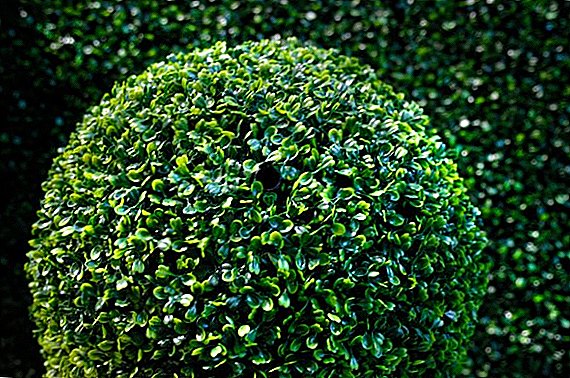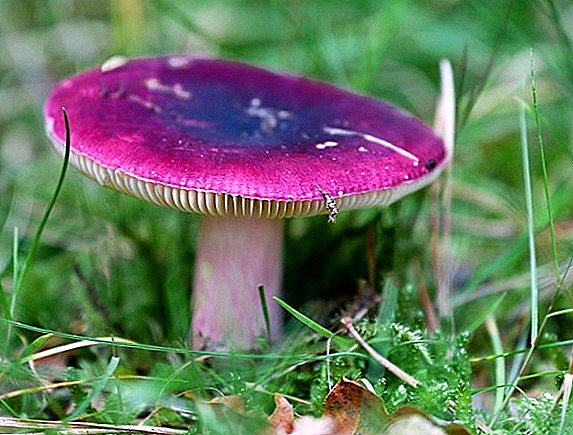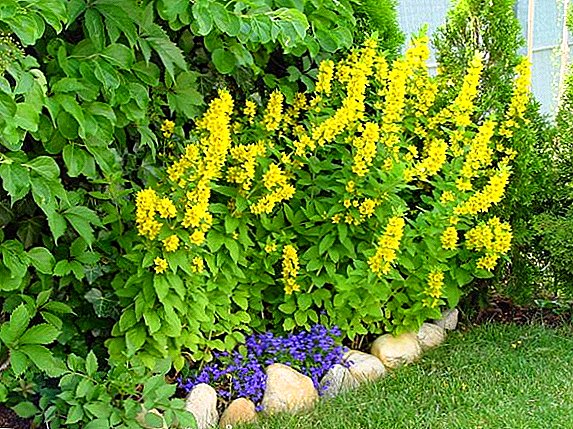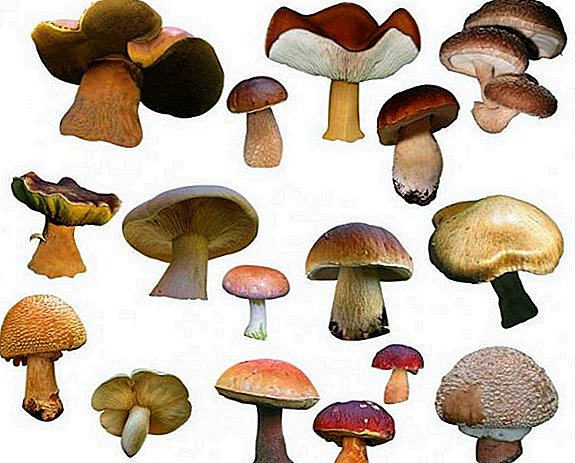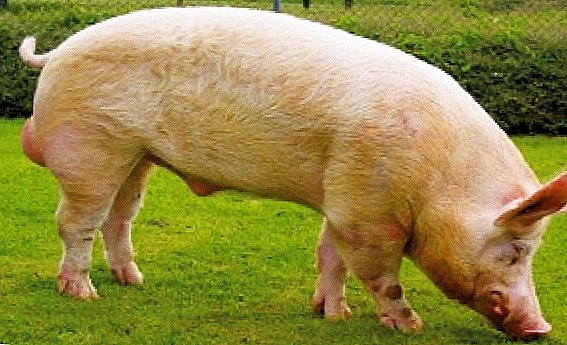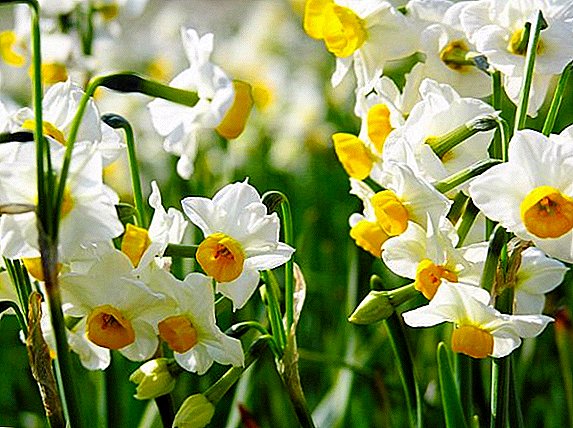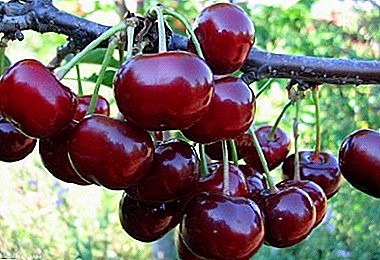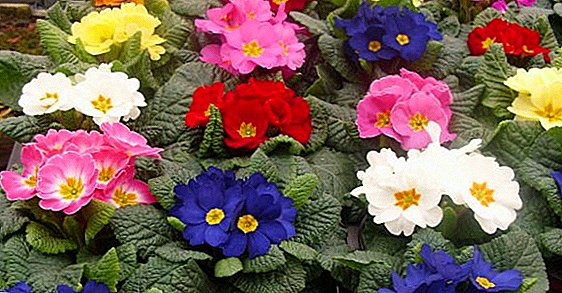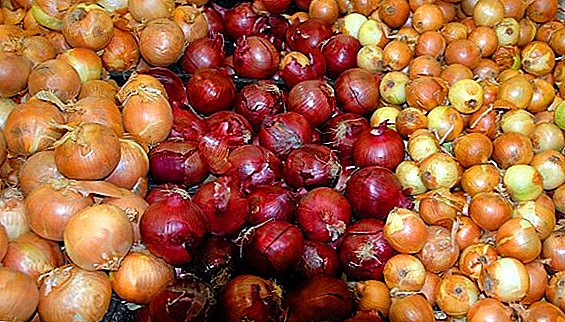 Onions are one of the most popular crops that grow all gardeners, regardless of the climatic zone or rainfall. After harvesting the problem often arises with the storage of onions.
Onions are one of the most popular crops that grow all gardeners, regardless of the climatic zone or rainfall. After harvesting the problem often arises with the storage of onions.
Facing the problem of spoiled products, the owners are wondering: so how to properly store onions to avoid losses? That's about it and will be discussed in our article.
How to prepare and dry onions for long-term storage
 Strange as it may seem, but a timely collected and properly dried onion will be well kept even in adverse conditions, therefore, preparation of onions for long-term storage should be done long before its collection.
Strange as it may seem, but a timely collected and properly dried onion will be well kept even in adverse conditions, therefore, preparation of onions for long-term storage should be done long before its collection.
Often, gardeners are faced with the fact that the roots are not gaining the necessary weight at the time of collection. This problem can be solved in several ways:
- Bending greens to the ground. This method gives the onion the opportunity to spend energy not on the green part, but on increasing the reserves in the root crop. Gardeners are advised to bend greens in June-July, depending on the climate.
- Cutting the roots or stripping the bulb. This method helps the plant to understand that all the energy you need to put on the accumulation of nutrients in the bulb. 14-15 days before harvesting, onion roots are slightly trimmed. If you are afraid to harm the plant or the bulb is too tight to sit in the ground, then you just need to otgresti ground, exposing the root. After this procedure, you can not water the onions, otherwise you risk collecting rotten products. Do not forget that you only need to strip the bulb in dry weather.
Did you know? Sweet onion varieties are grown only in the southern regions. They taste great and give a good harvest, but are poorly stored and unsuitable for long-term transportation.
Now let's talk about the harvest and proper drying.
Collect root should be exclusively in dry weather. Onions collected in rainy weather dries for a very long time and may start to rot. The root crop at the time of harvesting should be fully formed: the scales are colored red or its shades, the outer layers are dry and easily detach from the fruit, the greens are completely dry. 
Novice gardeners are often interested in the question: when is the best time to remove onion so that it is well kept. Depending on the climatic zone, onions are harvested either in the middle-end of August or in the month of September. In order not to damage the root crop, it is carefully lifted and slightly pulled by the tops. After harvesting, they start drying immediately.
Important! Damaged or rotten onions can not be put to dry with the bulk of the roots. Rejected bulbs are either discarded or eaten as soon as possible.
Dry onions in two ways: on a bed or under a canopy. If you are sure that during the next two weeks there will be warm, dry weather, then you can leave the excavated root crops in the beds. In the opposite case, the bow is laid out under covered sheds that protect the bow from the rain. Sheds should be well purged, dry and spacious.
The question often arises: how much onion should be dried in order to get rid of unnecessary moisture.
It all depends on the weather in which you collected the bow, on the room, on the ambient temperature and on the bow itself. On average, onions are dried for about two weeks. However, if the soil was wet or wet weather was established on the street, the drying period can reach 25-30 days. 
The main points to consider when drying onions.
- While drying, onions are laid out in one thin layer to speed up the process.
- Before drying, clean the onion carefully from the ground and plant residues (cutting the roots or tops is not necessary).
- While drying, onions should be turned several times to prevent rotting of the bottom.
- A few weeks after the start of drying, the onions are cut off (they cut the tops, leaving a neck 4-5 cm long). The roots are pruned slightly to prevent the root from sprouting.
- After trimming the onions are sorted and sorted. Storage takes a solid onion bright red color without visible damage.
Important! During the drying of onions it is necessary to exclude the ingress of moisture or debris on the roots.
Which onion varieties are best kept
Now let's talk about the best varieties of onions for storage. It is no secret that breeders have deduced many varieties of culture for various needs: for obtaining a large number of seeds, a huge harvest, a weighty green part or a specific taste. The attention of breeders attracted and keeping quality of products, so we have the opportunity to choose several varieties that are well preserved, while maintaining its structure and taste.
Did you know? In sharp varieties of onions contain a large amount of essential oils and sugars, which cause the sharpness of the root.
Red Baron.
 A variety of early ripe blue onions. Root crops have the correct form and weigh up to 150 g. Onions are used both for cooking various dishes and for preservation.
A variety of early ripe blue onions. Root crops have the correct form and weigh up to 150 g. Onions are used both for cooking various dishes and for preservation.
Root crop has a sharp taste, so great for marinades. After proper collection and drying, the roots are perfectly stored in any dry room.
Strigunovsky local.
Early ripe variety of yellow onions. It grows in hot and cool climates. The bulbs have a round shape and weight up to 80 g. The root pulp is very sharp. It is used both for preservation and for the preparation of various dishes.
Important! All sharp onion varieties are precocious and well kept. Root crops of such varieties are covered with several layers of outer scales.
Sturon.
Mid-season variety of yellow onions. Variety "Sturon" has several features: resistant to rifle and diseases. The bulbs are round, dense, painted in golden color. The root crop has a mass of 90-140 g and has a sharp taste. In use, the bow is versatile. Root crops are perfectly stored, without losing their shape and dense structure.
Centurion F1.
 Hybrid mid-season ripe yellow onion. The hybrid has the same features as the Sturon variety. The pulp of the bulb is juicy, white, has a pungent taste.
Hybrid mid-season ripe yellow onion. The hybrid has the same features as the Sturon variety. The pulp of the bulb is juicy, white, has a pungent taste.
The root crop is rounded elongated, weighing about 80-140 g. Like the above varieties, it has universal use.
It is important to understand that these varieties can also be subject to decay if they are improperly harvested or poorly dried.
At what temperature to store onions
Many owners are interested in the temperature at which the onions are stored in the winter. After drying, the onions need to be collected and transferred to another place for long-term storage. In the allotted room it is necessary to create a special microclimate that will prevent the vegetables from freezing, rotting or germinating.
Did you know? Crushed fresh onions are applied to burns to reduce pain and prevent blistering. The root crop not only provides the necessary moisture in the damaged area, but also destroys the microbes around the burn.
The shelf life of onions is directly dependent on temperature, so we consider several possible options.
There are three ways to store root vegetables:
- cold;
- warm;
- combined.

Cold storage implies a decrease in temperature to -3 ˚C. With such storage, onion losses are minimal, but maintaining a constant temperature is quite difficult, and minimal fluctuations can spoil the entire crop (if the temperature in the room drops to minus 4-5 C, then the onion will freeze)
This method is suitable for specialized hangars in which accurate temperature is maintained with the help of control systems.
Warm way assumes storage of onions at a sufficiently high temperature (+ 18-22 ˚C). Such a temperature at no additional cost can be maintained in the house, but it is worth remembering that the humidity should be at least 60-70%. Such a microclimate can cause blackening of the walls or damage to furniture, so it is best to install heaters in the basement or cellar and transfer the bow there. To increase humidity, use containers with water.
Many owners are interested in the question of how to store onions so that it does not germinate. Root crops sprout only when there is an excess of moisture in the room. Therefore, if you notice that the onion has begun to sprout, lower the air humidity.
Combined method differs in its complexity, however, it allows to save products with minimal losses. Before the onset of cold weather, onions are stored indoors at a temperature of 18–20 ° C, keeping the air humidity at 60–70%.
 When the temperature outside the window becomes negative, the onions are slowly cooled (over several days) and stored at minus 1–3 ° C. In the spring, when the frosts pass, the onions are transferred to a warm room and stored at a temperature of at least +18 ° C.
When the temperature outside the window becomes negative, the onions are slowly cooled (over several days) and stored at minus 1–3 ° C. In the spring, when the frosts pass, the onions are transferred to a warm room and stored at a temperature of at least +18 ° C.
Important! Onions do not like a sharp change in temperature, so before moving from heat to cold (and vice versa), you need to create a kind of "buffer" zone with average temperatures.
Subject to all rules, roots can be stored for 200 days or more after being laid for storage.
Rules and ways to store onions in the cellar
The possibility of heating the room makes possible long-term storage of onions in the cellar. However, simply decompose the roots on the surface can not, otherwise they can persecute. Therefore, we consider the options for the storage of onions and talk about what the pros and cons it has.
Plastic or wooden cases
For storing onions you can use boxes with a large bottom area and a small height of the sides. It is necessary to fold the bow in them with a layer of no more than 50 cm (respectively, the height of the box should be no more than 60 cm). This storage container saves space, but it is worth remembering that the boxes should not come into contact with the floor and walls of the cellar. They can be placed on racks or benches. Onions should be stored in boxes in the event that you have little space in the cellar or a lot of products.

The problem of storage in the boxes is that the roots on the bottom of the container can choke and start to rot. You can learn about this only by smell or by unloading all containers. The boxes have a positive side.
The main advantage of such storage containers - rot does not spread beyond the box (unless they stand close to each other).
When using boxes for long-term storage of onions, we recommend checking the quality of the products at least once a month to avoid rotting of a large number of onions.
Linen bags
In linen bags, you can also save onions in winter. You need to use small bags, because the less production there is in them, the less chance that it will choke or become moldy.
The advantages of using bags include:
- cheapness;
- spaciousness;
- medium strength;
- reusability.
 Cons such packaging is also sufficient. If the onion begins to rot in the bag, then you cannot see it without emptying the entire contents. In addition, if the bag "put", then the lower bulbs choke.
Cons such packaging is also sufficient. If the onion begins to rot in the bag, then you cannot see it without emptying the entire contents. In addition, if the bag "put", then the lower bulbs choke.You can have bags only with one layer, because, unlike boxes, they have no support and the whole mass presses on the bottom layer of root crops.
Thus, it is best to store in bags the small amount of products that will be in them for a short time.
Important! It is forbidden to use cellophane bags, as they do not allow air to pass through and accumulate moisture.
Capron stockings or tights
 Many housewives keep onions in pantyhose (stockings). Oddly enough, this method of storage is not as bad as it seems: stockings are breathable and absorb moisture; In addition, through the tights you can see the quality of the bulbs and in time to reject rotten.
Many housewives keep onions in pantyhose (stockings). Oddly enough, this method of storage is not as bad as it seems: stockings are breathable and absorb moisture; In addition, through the tights you can see the quality of the bulbs and in time to reject rotten.
On a small scale, this method of storage is not bad, but if you have a few quintals of onion, then stockings will not be enough for half the product. Also do not forget that stockings can break.
Therefore, the use of stockings is possible only for storing a small amount of root crops.
Egg containers
This method of storage is suitable only for small and medium onions. Root crops are laid out in containers like eggs, closed and put on racks. You can use containers only if you have a lot of space in the cellar or few products. Onions in containers are not protected from rotting; however, one rotted onion will not destroy a hundred, therefore this method minimizes losses.
Important! It is better to use half-open plastic or rubber containers. Paper packaging is prohibited (they accumulate moisture and quickly decompose).
The disadvantages of such a container include poor air circulation between the roots and condensate that will form under the container lid and cause the bulbs to rot.
Bundles or braids
 Remembering the various options for how to store onions, it is worth remembering about the old-fashioned method - braid weave. If you decide to weave the bulbs into braids, then at the drying stage you cannot cut the tops.
Remembering the various options for how to store onions, it is worth remembering about the old-fashioned method - braid weave. If you decide to weave the bulbs into braids, then at the drying stage you cannot cut the tops.
Knitting a braid takes a lot of time. You will immediately need to think about how to hang it all up in the cellar so that the braids do not touch each other, walls or floor.
The advantages of this method include good air circulation, the absence of an extra load on each fruit (as in the case of boxes or bags) and the ability to control the quality of the bulbs.
However, it is worth considering that, as in the case of stockings, the tops are not very durable and vulnerable to rotting. Therefore, with increasing humidity, all the "braids" can be on the floor and quickly deteriorate.
How to store onions in the apartment
Talk about how to store onions at home. Many owners do not have large cellars or basements, and the onions need to be stored somewhere in the winter. Therefore, we consider the possible options for the storage of root crops in the apartment.
Wicker baskets
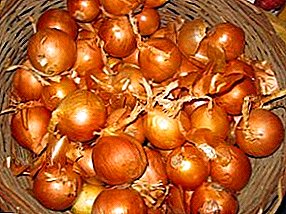 If you have several wicker baskets at home, then the onions are best preserved in them. The holes in the basket will not allow the onions to deteriorate, as good air circulation will be created. The material of the basket itself will not affect the roots.
If you have several wicker baskets at home, then the onions are best preserved in them. The holes in the basket will not allow the onions to deteriorate, as good air circulation will be created. The material of the basket itself will not affect the roots.
The only drawback of such a container is the pressure on the bottom layer. If you overdo it and put too many onions in the basket, simply crush the roots on the bottom and they will start to rot.
The holes in the basket can give a negative effect: through them, pests or water can easily get to the bow.
Plastic or wooden cases
As in the case of the cellar, the boxes can be useful when stored in an apartment. Using such a container, you can save a huge amount of space, but do not forget that the lack of moisture does not mean that the bow does not bend from crush or poor ventilation.
We advise you to load the boxes with onions to a minimum and mix them from time to time so that the onions are better preserved.
Did you know? The reason for such a tearful onion lies in a special substance - a lacrimator. When the onion is cut, the lacrimator is released and dissolved in water and, in particular, in human tears. This forms sulfuric acid, which irritates the mucous membrane of the eye.
Carton boxes
 Onions for the winter can be put in ordinary cardboard boxes, but storing vegetables in such a container is not the best option. The boxes are not only badly breathable, but they can get wet or tear. In addition, as in the boxes, there is pressure on the bottom layer of the roots.
Onions for the winter can be put in ordinary cardboard boxes, but storing vegetables in such a container is not the best option. The boxes are not only badly breathable, but they can get wet or tear. In addition, as in the boxes, there is pressure on the bottom layer of the roots.
If you decide to store onions in cardboard boxes, then make a large number of small holes on all sides to ensure minimal access to fresh air.
Polypropylene mesh
Such containers are often used for storing onions in large supermarkets. Polypropylene mesh provides good air circulation and allow you to see damaged products in time. If such container cannot be used in the cellar, then in the apartment the onion is not threatened with high humidity, and the net is one of the best options.
 However, it is worth remembering that through the net you will only see the outermost layer of onions. If there are rotten root crops in the center of the bag, then in order to sort out and remove the spoiled one, you need to empty the whole bag. Therefore, either use small bags or carefully inspect products before backfilling.
However, it is worth remembering that through the net you will only see the outermost layer of onions. If there are rotten root crops in the center of the bag, then in order to sort out and remove the spoiled one, you need to empty the whole bag. Therefore, either use small bags or carefully inspect products before backfilling.
Fabric or paper bags
Fabric and paper bags are used to store onions in an apartment only if there are no other options. In this bag, you can not see the spoiled roots, there is always pressure on the lower layer and poor air circulation. If you stopped on this option, then try to choose smaller bags or pack up the onions so that its height in the bag is no more than 30 cm.
Stockings or pantyhose
If no one sees such a “tara” in the basement, then the stockings with a bow hanging in the apartment not only look strange and give a steady smell, but also take up a lot of space. Stockings are still a good option if you do not take into account the aesthetic appearance. They absorb moisture and allow air to circulate between the bulbs.
Important! When storing onions in an apartment, the container cannot be placed near heating appliances or windows.
Bundles or braids
 Perhaps one of the best options for storing onions in the apartment. Wicker "braid" can be placed in a closet or closet (take care that the room was dry). Onions do not touch the floor, receive access to fresh air, there is no pressure on the bulbs.
Perhaps one of the best options for storing onions in the apartment. Wicker "braid" can be placed in a closet or closet (take care that the room was dry). Onions do not touch the floor, receive access to fresh air, there is no pressure on the bulbs.
Вы в любой момент сможете провести осмотр на наличие подгнивших луковиц или взять одну головку для приготовления блюда.
The negative side - a great investment of time for "knitting"; low strength "braids".
Tricks for long storage of onions
WITHThere is a considerable number of ways to help protect the onions from moisture or germination. Using our tips, you can save the entire crop without loss.
- Chalk absorbs moisture very well, so while keeping onions in a cellar or other damp room, add 200 g of chalk to 10 kg of products in a container with root vegetables.
- Clay or lime helps to stop the onion germination. If the roots began to sprout, you need to cut the roots and smear them with clay or lime solution. It must be remembered that such a bow will be unsuitable in the form of planting material.
- Raw onions can be dried using an oven, fireplace or battery. To dry the vegetables in the oven, you need to expand them in one thin layer, turn on the minimum and leave the door open. When the husks on the onions become dry and will be easily separated, the drying can be completed.
- To reduce the humidity in the room, you can install with buckets of ash or sand. These materials absorb moisture well and can be reused.

Did you know? Onions contain more natural sugar than apples and pears. Onion slices contain 6% sugar.
Now you know enough to collect products in time, dry them properly and keep them until spring. We told you what you need to store onions at home or in the cellar, how to deal with possible problems and what kind of better it is. Follow the described rules, and the harvest will lie more than one decade.


